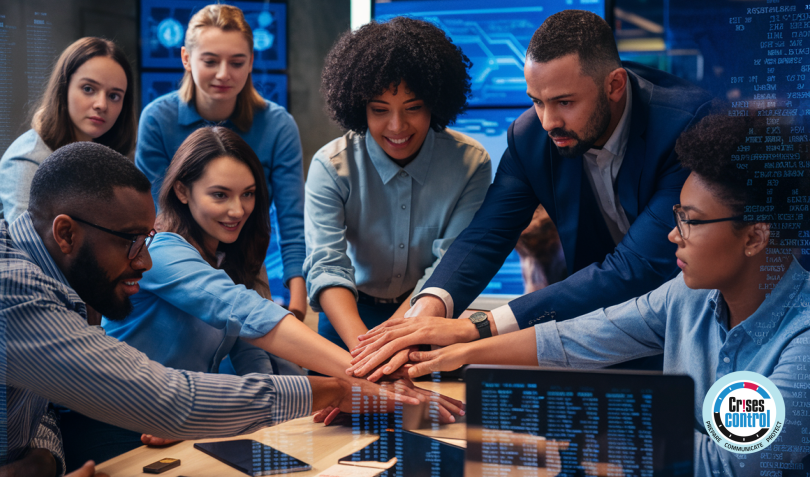Written by Anneri Fourie | Marketing Executive
In today’s volatile business environment, the ability to respond effectively to crises is more critical than ever. Companies face a range of potential disruptions—from natural disasters and cyber-attacks to supply chain interruptions and public health emergencies. The difference between surviving and thriving in such scenarios often comes down to preparation. One of the most effective tools for enhancing crisis preparedness is the Tabletop Exercise. These exercises simulate real-world scenarios, allowing teams to test their response strategies, identify gaps, and build confidence in their crisis management plans.
This blog will explore the benefits of tabletop exercises, provide a practical guide for managers looking to implement them, and highlight how Crises Control can support your business continuity efforts.
What Are Tabletop Exercises?
Tabletop Exercises are discussion-based sessions where team members come together to walk through a simulated crisis scenario. Unlike full-scale drills or live simulations, tabletop exercises are conducted in a low-stress environment, making them ideal for brainstorming and problem-solving. Participants engage in a guided discussion, exploring their roles, responsibilities, and the actions they would take during a crisis. This collaborative approach not only enhances individual understanding, but also fosters teamwork and communication.
Tabletop exercises differ from other forms of crisis preparation, such as functional exercises or live drills, in that they focus on the strategic aspects of crisis management rather than the operational details. This allows teams to think critically about their decisions, weigh the consequences, and consider alternative approaches in a risk-free setting.
The Benefits of Tabletop Exercises for Business Continuity

1. Risk Identification and Mitigation
One of the primary advantages of tabletop exercises is their ability to uncover risks that may not be apparent during the planning phase. By simulating a crisis, these exercises allow teams to identify vulnerabilities in their Business Continuity plans that might otherwise go unnoticed. For example, a tabletop exercise might reveal that a key decision-maker is unavailable during certain hours, or that a communication channel is prone to failure under heavy use.
By identifying these risks in advance, companies can take proactive measures to mitigate them, such as cross-training employees or investing in more robust communication tools. This not only strengthens the overall resilience of the organisation, but also reduces the likelihood of disruptions during an actual crisis.
2. Enhancing Communication and Coordination
Effective crisis management depends on clear and timely communication. Tabletop Exercises provide an opportunity to test and refine communication protocols, ensuring that all team members know their roles and responsibilities. During these exercises, participants can practise sending alerts, sharing updates, and coordinating with external stakeholders, such as emergency services or suppliers.
For example, in a simulated cyber-attack scenario, the IT team might need to quickly communicate with the legal department to assess compliance issues or inform the public relations team to manage external messaging. By practising these interactions in a controlled environment, teams can identify and address potential communication breakdowns, leading to smoother and more efficient responses in real-life situations.
3. Building Confidence in Crisis Response
When a crisis strikes, confidence in your team’s ability to respond effectively can make all the difference. Tabletop Exercises help build this confidence by providing a safe space to test and refine response strategies. Teams can experiment with different approaches, learn from their mistakes, and gradually improve their performance over time.
The iterative nature of tabletop exercises allows companies to continually enhance their crisis management capabilities. Each exercise builds on the last, enabling teams to become more agile and adaptive in the face of emerging threats. This increased confidence not only reduces anxiety during a crisis, but also empowers teams to make better decisions under pressure.
4. Continuous Improvement of Business Continuity Plans
Tabletop Exercises are not a one-time event, but rather an ongoing process of continuous improvement. After each exercise, teams should conduct a thorough debriefing to evaluate what went well, what didn’t, and what could be improved. This feedback loop is essential for keeping Business Continuity plans up to date and aligned with the ever-changing risk landscape.
For instance, a tabletop exercise might reveal that a backup generator is insufficient to power critical systems during an extended outage. Based on this insight, the company might decide to invest in additional backup power or develop contingency plans for relocating operations. By regularly incorporating lessons learned from tabletop exercises, businesses can ensure that their continuity plans remain robust and effective.
Implementing Tabletop Exercises in Your Organisation

1. Planning Your Tabletop Exercise
The first step in implementing a successful tabletop exercise is careful planning. Start by defining clear objectives: What do you hope to achieve? Are you testing a specific aspect of your Crisis Management plan, such as communication protocols or decision-making processes? Or are you conducting a more comprehensive assessment of your overall preparedness?
Once your objectives are defined, select a realistic scenario that aligns with your organisation’s risk profile. Scenarios should be relevant to your industry and consider potential threats such as natural disasters, cyber-attacks, or supply chain disruptions. For example, a manufacturing company might simulate a fire in a key production facility, while a financial institution could explore the impact of a major data breach.
Finally, determine the participants who should be involved in the exercise. These typically include members of the crisis management team, department heads, and other key stakeholders. It’s important to ensure that all relevant roles are represented, as this will provide a more accurate assessment of your company’s preparedness.
2. Conducting the Tabletop Exercise
On the day of the exercise, begin with a brief overview of the scenario and the objectives. Encourage participants to approach the exercise as if it were a real crisis, but remind them that the goal is to learn, not to perform perfectly. Throughout the exercise, facilitate open discussion and encourage participants to think critically about their decisions and actions.
As the exercise unfolds, introduce unexpected developments or “injects” to test the team’s adaptability. For example, you might simulate the failure of a key piece of equipment or the unavailability of a critical team member. These challenges will help participants think on their feet and develop creative solutions to unforeseen problems.
It’s also important to have a scribe or note-taker document the discussion and decisions made during the exercise. This documentation will be invaluable during the debriefing process, as it provides a detailed record of the exercise that can be reviewed and analysed.
3. Post-Exercise Review and Follow-Up
After the exercise, gather all participants for a debriefing session. This is where the real value of the tabletop exercise comes to light. Discuss what went well, what didn’t, and what lessons were learned. Be sure to capture specific insights that can be used to improve your Business Continuity plans.
For example, if the exercise revealed a communication breakdown between the IT and legal teams, you might decide to revise your communication protocols or conduct additional training for those departments. Similarly, if a critical piece of infrastructure failed during the simulation, you might prioritise its upgrade or replacement.
Follow up on the insights gained by updating your crisis management plans and scheduling additional tabletop exercises to test the new strategies. This continuous improvement process will help your organisation stay prepared for any crisis, no matter how complex or unexpected.
How Crises Control Can Help
Crises Control offers a suite of tools and resources that can enhance your tabletop exercises and overall crisis management strategy. Here’s how our platform can support your efforts:
1. Comprehensive Crisis Management Tools
Crises Control provides an all-in-one platform that integrates key features such as Ping Mass Notification, Incident Manager, Task Manager and more. These tools can be incorporated into your tabletop exercises to simulate real-world scenarios with greater accuracy and effectiveness. For example, you can use our Ping Mass Notification system to send alerts during the exercise, testing your team’s response to critical updates in real-time.
2. Easy Scenario Simulation
Our platform allows you to create and simulate a wide range of crisis scenarios tailored to your organisation’s unique risks. With Crises Control, you can quickly develop exercises that test specific aspects of your crisis management plan, from cyber threats to natural disasters. This flexibility ensures that your tabletop exercises are always relevant and challenging.
3. Real-Time Communication
During a crisis, every second counts. Crises Control’s instant alerts and notifications ensure that your team stays informed and connected throughout the exercise. Our platform mimics real-world communication dynamics, helping you identify and address any potential bottlenecks or breakdowns in your crisis response.
4. Detailed Reporting and Analysis
After the exercise, Crises Control provides detailed reports that capture every decision and action taken during the simulation. These reports offer valuable insights into your team’s performance, highlighting strengths and areas for improvement. By analysing this data, you can refine your business continuity plans and ensure your organisation is better prepared for future crises.
Conclusion: Take the Next Step in Crisis Preparedness
Tabletop Exercises are a powerful tool for enhancing your organisation’s crisis preparedness and business continuity. By simulating real-world scenarios, these exercises help you identify risks, improve communication, and build confidence in your crisis management strategy. Implementing regular tabletop exercises is an investment in your company’s resilience, ensuring that you’re ready to face any challenge that comes your way.
At Crises Control, we’re committed to helping businesses like yours strengthen their crisis management capabilities. Our comprehensive platform is designed to support every stage of your tabletop exercises, from planning and execution to post-exercise review and continuous improvement.
Ready to take your crisis preparedness to the next level? Contact us today to get a free personalised demo and discover how Crises Control can help you protect your business and ensure its continuity, no matter what the future holds.
Request a FREE Demo

